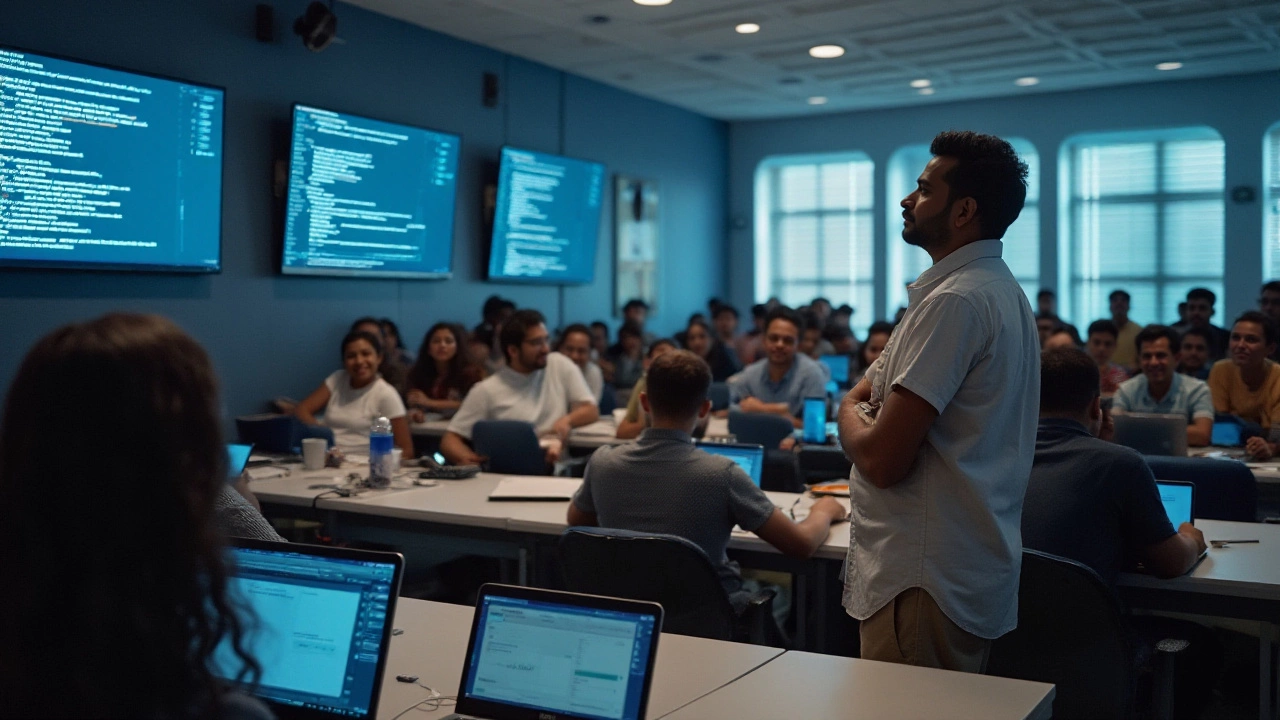Python, with its growing popularity, often stands out as the go-to language for those dipping their toes into the world of programming. Its simplicity and clarity in design appeal to beginners who might initially find coding daunting. Learning Python is akin to learning a language that speaks as much to humans as it does to machines, with its straightforward syntax and vast community support.
The appeal of Python lies in its versatility. Whether you’re interested in web development, data analysis, artificial intelligence, or even art, Python provides a solid foundation. This article explores whether Python truly is easy to learn, diving into what makes it accessible and the potential hurdles beginners might encounter along the journey.
- Introduction to Python
- Why Python is Considered Easy
- Common Challenges Faced by Beginners
- Resources to Learn Python
- Applying Python in Real-World Scenarios
Introduction to Python
When you first dive into the world of programming, Python often emerges as a favorite. Its origin story begins with Guido van Rossum, a Dutch programmer, who in the late 1980s, sought to create a language that effortlessly combined simplicity and power. His inspiration sprouted from a desire to overcome the limitations he observed in other languages. Unlike many of its predecessors, Python was designed as a high-level language, which means it's closer to human languages than to machine languages, making it more approachable for beginners.
Python’s design philosophy emphasizes code readability, having the distinction of encouraging programmers to write clear and logical code for both small and large-scale projects. Its syntax, heavily inspired by ABC language and resembling pseudo-code, requires fewer lines to declare concepts compared to other languages like C++ or Java. This not only reduces the time to write code but also simplifies debugging, a critical aspect for any programmer. Thanks to its readability, beginners can focus more on learning programming concepts rather than wrestling with syntax.
Python has been lauded not just for its elegance but also for its community. As of today, it maintains one of the most active communities among programming languages, with countless forums, user groups, and conferences dedicated to supporting newcomers.
Tim Peters, one of Python's key contributors, famously summarized Python's guiding principles in 'The Zen of Python,' which begins with, 'Beautiful is better than ugly. Simple is better than complex.'Such a philosophy relaxes the learning curve and appeals to those who fear the steepness of starting their coding journey.
The language’s versatility is unmatched. From web development with frameworks like Django to data analysis with libraries such as Pandas, and machine learning powered by TensorFlow, Python fits seamlessly into any domain. Its cross-platform nature allows coders to develop on different operating systems without worrying about compatibility, fundamentally making it a skill worth investing in. The ability to transition between different fields using the same language adds to its charm and practicality, capturing the interests of curious minds eager to explore technology's vast realms.
Python’s strength isn't just in its simplicity but in its prowess as a practical tool in diverse fields. According to a 2023 Stack Overflow survey, Python continues to rank among the top three most loved programming languages among developers globally, continuously broadening its presence in the tech industry. This statistic is a testament to its success story, securing it a spot in educational curriculums worldwide as the first language taught to aspiring programmers. As students and professionals explore Python, they are armed with an extensive range of libraries and tools that support intense computational tasks, a feature that has mainstreamed Python in academia and tech companies alike.
In essence, Python is more than just a language; it’s a gateway into the tech universe, offering an invitation to those curious enough to embark on a limitless journey. Its blend of simplicity, community, and utility makes it an excellent starting point for any budding programmer. Whether you aim to create the next viral app or delve into the depths of artificial intelligence, understanding Python lays a strong foundation to turn your aspirations into reality. So why not take the plunge into Python and see where your coding adventure leads you?
Why Python is Considered Easy
When one considers the landscape of programming languages, Python consistently rises to the top as an accessible and friendly language for newcomers. Its design philosophy emphasizes readability and simplicity, making it a refreshing choice for those unaccustomed to the cryptic scripts associated with programming. One of the primary features contributing to Python's ease is its clear syntax, which closely resembles the English language. Unlike more convoluted languages, Python's straightforward approach allows learners to focus more on problem-solving and less on the semantics. A line of Python code generally requires fewer instructions than languages like C++ or Java, removing unnecessary complexities and reducing the learning curve significantly.
Another reason Python is deemed easy to learn lies in its comprehensive standard library. This rich library provides modules and functions readily available for basic tasks such as file I/O, data processing, and more complex tasks like web development and machine learning. This built-in resource pool is complemented by Python's extensive external libraries, further broadening the capabilities of projects and ensuring that beginners have a toolkit at their disposal without needing to build from scratch. Access to such resources translates to less code writing and more project-building, keeping the motivation and excitement alive for learners.
The strong community support surrounding Python serves as another pillar for its learning ease. Any beginner will inevitably face challenges, but Python's community is known for being welcoming and supportive. There are countless forums, online courses, and documentation aimed at helping new programmers, ensuring they do not feel isolated or overwhelmed. As Guido van Rossum, the creator of Python, once said during an interview, "My goal was to create an easy and intuitive language just as powerful as major competitors." This ethos of simplicity and support has persisted within the Python community, facilitating learning through shared knowledge and collaborative problem-solving.
"Python's simple syntax emphasizes readability and reduces the cost of program maintenance. Python supports modules and packages, which encourages program modularity and code reuse." — Python.org
Lastly, Python’s versatility motivates learners by offering a rainbow of possibilities, from web applications and data science to artificial intelligence and automation. This universality ensures that whatever the interest or project, learners can pursue their passion without switching languages, nurturing a deeper understanding and retention of concepts. As the barrier to entry is lowered by these factors, along with plenty of resources and community backing, it's not surprising that Python remains a top choice for aspiring coders looking to embark on their programming journey with an excessively steep learning curve.

Common Challenges Faced by Beginners
Diving into the world of Python can be both exciting and, at times, intimidating for newcomers. While Python is heralded for its simplicity, beginners often encounter hurdles that test their patience and dedication. One primary challenge is understanding the basic concept of programming logic itself. Many users come from non-technical backgrounds and wrapping one's head around loops, conditions, and variables can initially seem like learning a new language altogether.
Another issue is a lack of patience during the debugging process. Novices might expect their code to work on the first try, making debugging frustrating. It's a known fact that debugging is indeed an art, as storied by many developers who've spent countless hours perfecting this skill. This requires a mindset shift—which is a part of learning how computers 'think' in their own, hyper-logical way. Coupled with this is the common struggle with error messages. The cryptic red text displayed when something goes wrong is often bewildering, leaving beginners unsure of how to proceed.
According to a survey conducted by Stack Overflow, nearly 50% of new programmers report stalling their progress due to discouragement from unresolved coding issues. Furthermore, many newcomers struggle with the abstract notion of understanding libraries and modules. When faced with Python's vast ocean of libraries, a beginner might be uncertain about which tools to deploy for specific tasks. It’s akin to having all the ingredients for a dish but not knowing the recipe.
"Learning to program is like acquiring problem-solving skills," notes Guido van Rossum, the creator of Python. "It's not just about writing code, but about thinking critically and logically."
Even choosing the right resources can be a daunting task. With so many books, online courses, and tutorials, selecting the right one that matches one's learning style is critical. Some might prefer interactive tutorials, while others might gain more from traditional textbook learning or video lessons. Whichever route they choose, staying consistent with it is vital. Persistence is key, even when dealing with setbacks.
Resources to Learn Python
Embarking on a journey to learn Python can be thrilling, thanks to the abundance of online resources that cater to different learning styles. From https://www.codecademy.com/interactive video tutorials to comprehensive documentation, beginners have an array of options to choose from. For the hands-on learner, platforms like Codecademy and Coursera offer interactive courses that walk you through each concept with real-time coding exercises. These platforms often award completion certificates, which can boost your confidence as you progress.
For those who prefer reading, books like "Automate the Boring Stuff with Python" by Al Sweigart are excellent resources. This book introduces you to Python in a practical way, focusing on how you can automate daily computer tasks. It doesn’t just teach you the language but gives you real projects that can be implemented immediately. Furthermore, the Python documentation is a treasure trove of information, though it might appear daunting at first glance. Dive into specific topics and come out with a clearer understanding of how Python functions at a fundamental level.
"The beautiful thing about learning is that nobody can take it away from you." – B.B. King
Another exciting way to learn is through community involvement. Platforms like Stack Overflow, Reddit’s r/learnpython, and the Python.org community forums are crucial in connecting you with thousands of Python enthusiasts and experts. Asking questions, sharing your projects, and even helping others can accelerate your learning curve. Many beginners find solace knowing they have a vast community to fall back on when the programming seas turn choppy.
Podcasts and YouTube channels now offer a way to learn on the go. Listening to podcasts like "Talk Python To Me" during your daily commute can keep you immersed in the world of Python. Video content, with channels like Corey Schafer’s and Sentdex, breaks down complex topics into manageable video snippets, and learning through visuals helps reinforce information effectively.
Lastly, for those who love a structured curriculum, enrolling in a Python bootcamp might be the way to go. These bootcamps, although more intensive and costly than other resources, provide a comprehensive and immersive learning experience. Programs like General Assembly and Le Wagon offer online and in-person options that cover Python extensively, ensuring you leave with a strong grasp of the language and some project work to show for it. With these resources at your disposal, diving into the realm of Python becomes less of a daunting task and more of an exhilarating adventure.

Applying Python in Real-World Scenarios
Python’s versatility makes it a jack-of-all-trades in the realm of programming, adept for anyone wanting a taste of multiple fields. Its use covers an impressive spectrum, from web development to scientific computing. In web development, Python frameworks like Django and Flask simplify the development process, allowing for the creation of robust, scalable web applications. These frameworks are known for their security and efficiency, qualities that attract startups and established companies alike.
In the field of data science, Python shines brightly. It’s no secret that it’s the language of choice for data scientists, thanks to libraries like NumPy and Pandas that simplify data manipulation. These tools allow data analysts to cleanse and prepare data almost effortlessly. Consider machine learning as well, where Python's libraries such as TensorFlow and PyTorch make model development achievable for both new and experienced developers. This accessibility is vital in pushing the boundaries of artificial intelligence, allowing for rapid advancements.
Python’s role in automating tasks cannot be overstated. From simple scripts that rename files to sophisticated bots for web scraping, Python scripts streamline daily tasks, promoting productivity and efficiency. This ease of automation resolves repetitive chores, letting professionals focus on more strategic initiatives. A great example of this is Python's use in network security; security experts often use Python to automate penetration testing tasks.
Python and the Internet of Things (IoT)
Another exciting domain for Python is the Internet of Things (IoT). Python drives IoT projects forward, largely due to its capability to interact seamlessly with the hardware. Libraries such as PySerial enable communication with various devices, bridging the gap between physical hardware and digital interfaces. The simplicity of Python ensures that developers can prototype IoT solutions swiftly, often using platforms such as Raspberry Pi to test out ideas before moving to production.
Python also makes significant waves in the field of finance, where its ability to implement complex algorithms quickly comes into play. Custom trading strategies, predictive analytics for market behaviors, and even engaging in automatic trading can be accomplished with Python. Financial institutions capitalize on Python to manage transactional data and reduce trading timeframes, turning hours-long processes into tasks that take minutes.
Quotes From Experts
Its adaptability hasn't gone unnoticed in academia either, with Python being taught as the introductory language in many universities. As one professor remarks,
"Python's straightforward syntax lowers the barrier to entry, empowering students to focus on grasping foundational programming concepts rather than getting bogged down by syntactical idiosyncrasies."
The global demand for Python expertise reflects just how prevalent the language is. A glance at leading job portals shows Python as a highly sought-after skill, underscoring its real-world applicability. The ability to span sectors, from technology startups to banking giants, exemplifies Python’s indispensable role in modern industry, making it not just a tool for solving problems but a gateway to countless opportunities.



